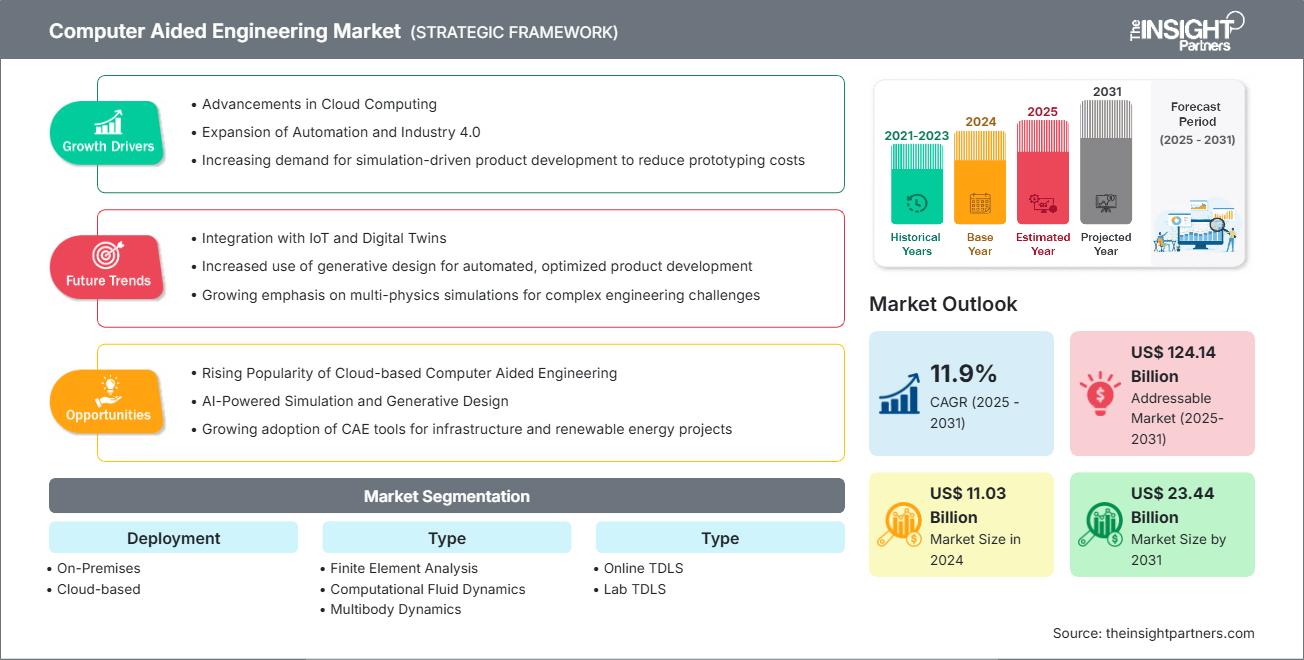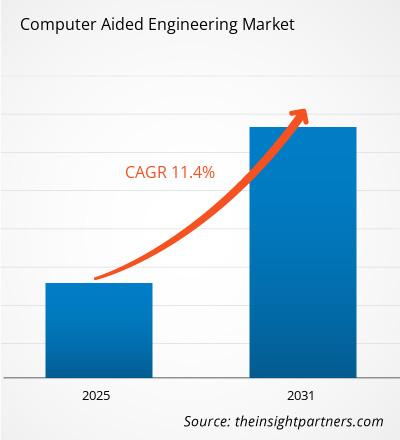预计到2031年,计算机辅助工程市场规模将从2024年的110.3亿美元增至234.4亿美元。预计该市场在2025年至2031年期间的复合年增长率将达到11.9%。
计算机辅助工程市场分析云计算的进步以及自动化和工业4.0的发展推动了对计算机辅助工程的需求。市场增长主要得益于基于云的计算机辅助工程以及人工智能驱动的仿真和生成设计的普及。预计与物联网和数字孪生的融合将成为未来市场的主要趋势。然而,高昂的初始投资成本阻碍了市场增长。
计算机辅助工程市场概览计算机辅助工程 (CAE) 是计算机软件的广泛应用,用于支持工程分析任务,包括产品和制造工具的仿真、验证和优化。它涵盖增强和简化工程设计流程的数字技术,使工程师能够在构建物理原型之前在实际条件下测试产品性能、行为和可靠性。CAE 工具包括用于结构分析的有限元分析、用于流体流动模拟的计算流体动力学以及用于研究机械系统运动的多体动力学。这些工具可以快速迭代和改进设计,从而降低与物理原型设计相关的成本和时间,同时提高产品质量和创新能力。 CAE 与计算机辅助设计 (CAD) 和产品生命周期管理 (PLM) 系统相集成,为工程师提供了一个虚拟环境,以预测和解决工程问题、优化复杂系统并在整个产品开发周期内做出数据驱动的决策,从而增强竞争力并加速市场增长。
您将免费获得任何报告的定制,包括本报告的部分内容,或国家级分析、Excel 数据包,以及为初创企业和大学提供超值优惠和折扣
计算机辅助工程市场: 战略洞察

-
获取本报告的主要市场趋势。这个免费样本将包括数据分析,从市场趋势到估计和预测。
计算机辅助工程 (CAE) 市场驱动因素和机遇
市场驱动因素:-
对仿真驱动产品设计的需求不断增长
公司越来越依赖仿真工具来减少物理原型、降低成本并加快产品开发周期。 -
采用基于云的 CAE 解决方案
云平台使 CAE 工具能够实现更快的计算、更轻松的协作和经济高效的可扩展性,从而推动了各行各业的广泛采用。 -
人工智能和机器学习集成方面的进步
将人工智能/机器学习 (AI/ML) 集成到 CAE 软件中可以增强预测建模、自动化设计优化并提高仿真准确性。 -
汽车和航空航天工业的扩张
这些行业在碰撞测试、热分析和空气动力学建模方面投入了大量资金,从而推动了市场需求。 -
物联网 (IoT) 使用率不断上升和数字孪生技术
集成物联网和数字孪生可实现实时仿真和性能监控,从而创造新的 CAE 应用机会。
市场机遇:
-
电动和自动驾驶汽车中的新兴应用
向电动汽车和自动驾驶技术的转变需要先进的仿真工具来提高电池性能、热管理和系统安全性。
-
医疗设备和医疗保健领域 CAE 的增长
CAE 工具越来越多地用于设计植入物、可穿戴设备和诊断设备,为生物医学工程提供了巨大的潜力。
-
扩展到中小企业 (SME)
随着基于云和订阅的 CAE 模型降低成本,越来越多的中小企业可以采用这些工具来提高设计准确性和产品创新。
-
需求增加用于可持续产品开发
CAE 通过生命周期分析、材料优化和能源效率建模支持环保设计,符合全球可持续发展目标。
-
与增材制造(3D 打印)集成
CAE 增强了 3D 打印组件的设计和测试,从而实现了更好的材料利用、更快的原型设计以及复杂几何形状的创新。
计算机辅助工程市场分为不同的细分市场,以便更清楚地了解其运作方式、增长潜力和最新趋势。以下是大多数行业报告中使用的标准细分方法:
按组件:
-
软件
指用于各种工程应用中的仿真、建模、分析和设计验证的 CAE 工具和平台。 -
服务
包括供应商提供的咨询、培训、维护和定制仿真服务等支持服务,旨在增强软件的使用和集成。
按部署模型:
-
本地部署
CAE 软件安装并运行在组织自己的服务器和基础架构上,提供对数据和自定义的完全控制。 -
基于云的
CAE 解决方案托管在远程服务器上并通过互联网访问,从而实现灵活性、可扩展性和更轻松的协作。
按软件类型:
- 有限元分析 (FEA)
- 计算流体动力学 (CFD)
- 多体动力学
- 优化与仿真
按软件类型:
- 汽车
- 国防与航空航天
- 电子
- 医疗设备
- 工业设备
- 其他
按地域:
- 北美
- 欧洲
- 亚太地区
- 中东和非洲
- 南美和中美洲
亚太地区的计算机辅助工程市场预计将见证最快的增长。中国、印度、日本和韩国等国家正在大力投资制造业并拓展高科技产业。这种扩展产生了对先进仿真工具的强烈需求,以优化产品性能并加快设计周期。
计算机辅助工程市场
The Insight Partners 的分析师已详尽阐述了预测期内影响计算机辅助工程市场的区域趋势和因素。本节还讨论了北美、欧洲、亚太地区、中东和非洲以及南美和中美洲的计算机辅助工程市场细分和地域分布。
计算机辅助工程市场报告范围
| 报告属性 | 细节 |
|---|---|
| 市场规模 2024 | US$ 11.03 Billion |
| 市场规模 2031 | US$ 23.44 Billion |
| 全球复合年增长率 (2025 - 2031) | 11.9% |
| 历史数据 | 2021-2023 |
| 预测期 | 2025-2031 |
| 涵盖的领域 |
By 部署
|
| 覆盖地区和国家 |
北美
|
| 市场领导者和主要公司简介 |
|
计算机辅助工程市场参与者密度:了解其对业务动态的影响
计算机辅助工程市场正在快速增长,这得益于终端用户需求的不断增长,而这些需求又源于消费者偏好的不断变化、技术进步以及对产品优势的认知度不断提升等因素。随着需求的增长,企业正在扩展产品线,不断创新以满足消费者需求,并抓住新兴趋势,从而进一步推动市场增长。

- 获取 计算机辅助工程市场 主要参与者概述
按地区划分的计算机辅助工程市场份额分析
预计未来几年亚太地区将增长最快。南美和中美洲、中东和非洲的新兴市场也为计算机辅助工程提供商提供了许多尚未开发的扩张机会。
每个地区的计算机辅助工程市场增长情况不同。这是由于技术进步、成本效益、数据安全和隐私、定制和支持需求等因素造成的。以下是按地区划分的市场份额和趋势摘要:
1.
-
市场份额:
得益于先进的工业和技术基础设施,占据了全球 CAE 市场的很大份额。 -
关键驱动因素:
- 领先的 CAE 软件供应商和技术创新者的强大影响力
- 广泛采用基于云和 AI 集成的工程解决方案
- 强大的汽车、航空航天和国防工业,需要先进的仿真工具
-
趋势:
数字孪生和物联网集成的使用越来越多,越来越重视仿真驱动设计,并通过云部署扩展中小企业的 CAE。
2.欧洲
-
市场份额:
全球主要市场之一,由制造业中心和严格的监管标准驱动。 -
关键驱动因素:
- 高度重视可持续性和环保产品开发
- 汽车巨头和航空航天制造商投资 CAE
- 政府举措推动工业 4.0 和数字化转型
-
趋势:
增材制造模拟的采用率不断提高,CAE 和 CAD 系统之间的协作不断增强,以及基于云的 CAE 采用率不断增长。
3.
-
市场份额:
该地区发展迅速,制造业和汽车行业不断扩张。 -
关键驱动因素:
- 工业化和基础设施建设不断加强
- 电动汽车和智能制造投资不断增加
- 中小企业对先进 CAE 技术的认识和采用不断提高
-
趋势:
基于云的 CAE 解决方案激增、研发活动增强以及对实时仿真和测试工具的需求不断增长。
4.
5. 中东和非洲-
市场份额:
对制造业和汽车行业兴趣日益增长的发展中市场。 -
关键驱动因素:
- 不断扩大的汽车和航空航天制造活动
- 由于成本优势,基于云的 CAE 工具的采用率不断提高
- 当地行业对产品创新和模拟的需求不断增长
-
趋势:
为 CAE 用户增加培训和支持服务,采用混合部署模型,并逐步整合人工智能驱动的模拟工具。
5. 中东和非洲
-
市场份额:
受基础设施和能源行业发展驱动的新兴市场,具有潜力。 -
关键驱动因素:
- 越来越关注基础设施项目需要工程模拟
- 石油和天然气需求的增长天然气和可再生能源行业对 CAE 工具的需求
- 政府对数字化转型和智慧城市计划的投资
-
趋势:
采用 CAE 进行能源效率分析,增加与全球 CAE 供应商的合作伙伴关系,并逐步转向云部署。
高市场密度和竞争
由于 Autodesk Inc、Hexagon AB、Ansys Inc、Altair Engineering, Inc.、Dassault Systemes SE、Bentley Systems Inc、PTC Inc、Siemens AG、Satven 和 Technosoft Engineering Projects Ltd. 等老牌参与者的存在,竞争非常激烈,也加剧了不同地区的竞争格局。
这种激烈的竞争促使公司通过提供以下产品脱颖而出:
- 先进的仿真功能,包括多物理场、
- 人工智能驱动的优化和实时分析
- 与 CAD、PLM 和 IoT 平台集成的综合软件套件,可实现无缝产品开发
- 灵活的部署模型,包括基于云的解决方案和混合解决方案,可满足不同的客户需求
- 强大的客户支持和服务产品,例如咨询、培训和定制
机遇与战略举措
- 扩展基于云的 CAE 解决方案,通过降低进入门槛和成本来吸引中小企业和初创企业
- 投资研发以增强人工智能和机器学习集成,从而实现更智能、更快速的仿真工作流程
- 针对电动汽车、可再生能源和生物医学工程等新兴行业,提供量身定制的解决方案
- 与 CAD、PLM 和硬件供应商建立战略合作伙伴关系,提供端到端的数字工程生态系统
- 开发培训计划和认证课程,以建立熟练的用户群并提高
- 采用
- Autodesk Inc.(美国)
- Hexagon AB(瑞典)
- Ansys Inc.(美国)
- Altair Engineering, Inc.(美国)
- Dassault Systèmes SE(法国)
- Bentley Systems Inc.(美国)
- PTC Inc.(美国)
- Siemens AG(德国)
- Satven(印度)
- Technosoft Engineering Projects Ltd.(印度)
免责声明:以上列出的公司没有按任何特定顺序排名。
在研究过程中分析的其他公司有:
- MathWorks
- Cadence Design系统
- ESI Group
- SimScale GmbH
- Rescale, Inc.
- Zuken Inc.
- NEi Software
- Exa Corporation
- MSC Software
- NUMECA International
- COMSOL Inc.
- Aspen Technology Inc.
- Ceetron
- Murata Software有限公司
- LMS International
- Dayton T. Brown, Inc.
- OptiPro Systems
- Simularge
- AVEVA Group plc
- Expleo Group
- Caelynx
- SOLIZE Corporation
- Eleno Energy
- Sphinx Worldbiz
- ZWSOFT有限公司
发展
>-
PTC 宣布推出其 Creo 计算机辅助设计 (CAD) 解决方案的最新版本
PTC 宣布推出其 Creo 计算机辅助设计 (CAD) 解决方案的最新版本,旨在帮助制造商在更短的时间内交付最佳设计。Creo 12 为其设计、仿真和制造功能引入了数百项强大的增强功能,使团队能够更智能地工作、完成更多工作并更有效地协作。 -
Autodesk, Inc. 宣布推出 Autodesk AI 技术
Autodesk, Inc. 宣布推出 Autodesk AI 技术,该技术可释放创造力、帮助解决问题并消除设计和制造我们周围世界的各行各业的非生产性工作。 Autodesk AI 内置于 Autodesk 产品中,并且是其设计和制造平台的原生功能,可提供智能辅助和生成功能,使客户能够自由想象和探索,同时生成精确、准确和创新的成果。
《计算机辅助工程市场规模和预测(2021-2031)》报告对以下领域进行了详细的市场分析:
- 涵盖范围内所有关键细分市场的全球、区域和国家/地区计算机辅助工程市场规模和预测
- 计算机辅助工程市场趋势以及市场动态,例如驱动因素、限制因素和关键机遇
- 详细的 PEST 和 SWOT 分析
- 计算机辅助工程市场分析,涵盖关键市场趋势、全球和区域框架、主要参与者、法规和最新市场发展
- 行业格局和竞争分析,涵盖市场集中度、热图分析、知名参与者以及计算机辅助工程市场的最新发展
- 详细的公司简介
- 历史分析(2 年)、基准年、预测(7 年)及复合年增长率
- PEST和SWOT分析
- 市场规模、价值/数量 - 全球、区域、国家
- 行业和竞争格局
- Excel 数据集
近期报告
相关报告
客户评价
购买理由
- 明智的决策
- 了解市场动态
- 竞争分析
- 客户洞察
- 市场预测
- 风险规避
- 战略规划
- 投资论证
- 识别新兴市场
- 优化营销策略
- 提升运营效率
- 顺应监管趋势






















 获取免费样品 - 计算机辅助工程市场
获取免费样品 - 计算机辅助工程市场